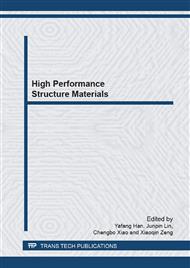[1]
G. Shen, S. L Semiatin, R. Shivpuri, Modeling microstructural development during the forging of Waspaloy, Metallurgical and Materials Transactions A. 26 (1995) 1795-1803.
DOI: 10.1007/bf02670767
Google Scholar
[2]
W.Y. Xu, G.Q. Zhang, Z. Li, Low Cycle Fatigue Behavior of Spray Formed Superalloy Rings, Advanced Materials Research. 399 (2012) 1937-(1941).
DOI: 10.4028/www.scientific.net/amr.399-401.1937
Google Scholar
[3]
H. Yuan, Z. Li, G.Q. Zhang, W.Y. Xu, N. Liu, Y. Zhang, S.F. Tian, The study of microstructures and properties of spray formed superalloy GH738 ring, Journal of Iron and Steel Research. Vol. 23 (2011).
Google Scholar
[4]
N. Liu, Z. Li, G. Zhang, Hot deformation behavior and microstructure evolution of spray formed GH738 superalloy, Rare Metals. 30 (2011) 388-391.
DOI: 10.1007/s12598-011-0309-2
Google Scholar
[5]
E. Lavernia, N.J. Grant, Spray deposition of metals: a review, Materials Science and Engineering. 98 (1988) 381-394.
DOI: 10.1016/0025-5416(88)90191-7
Google Scholar
[6]
D.L. Davidson, R.G. Tryon, M. Oja, R. Matthews, K.S. Ravi Chandran, Fatigue crack initiation in Wasploy at 20°C, Metallurgical and materials transactions A. 38 (2007) 2214-2225.
DOI: 10.1007/s11661-007-9178-6
Google Scholar
[7]
X.B. Liu, L.Z. Ma, K.M. Changand, E. Barbero, Fatigue crack propagation of Ni-base superalloys, Acta Metallurgica sinica A. 18 (2005) 55-64.
Google Scholar
[8]
E. Hershko, N. Mandelker,G. Gheorghiu, etc, Assessment of fatigue striation counting accuracy using high resolution scanning electron microscope, Engineering Failure Analysis. 15 (2007) 20-27.
DOI: 10.1016/j.engfailanal.2007.01.005
Google Scholar
[9]
X.Q. Hou, J.J. Fan, Z.B. Wang, Quantitative analysis on fatigue fracture of FGH95 alloy, Journal of Iron and Steel Research. Vol. 23 (2011) 471.
Google Scholar
[10]
Y. Zhang, W.F. Zhang, H. Yan, Quantitative analysis in evaluating fatigue Lives of components, Journal of Materials Engineering. (2000) 45-48.
Google Scholar
[11]
Z.H. Zhao, Z. Zhang, S.J. Wu, Q.P. Zhong, Survey of quantitiative reverse deduction from fatigue fracture suface of metals, Journal of Mechanical Strength. 30 (2008) 508.
Google Scholar
[12]
X.L. Zhang, Z. Zhang, C.H. Tao, Fatigue fractography quantitative analysis, National defense industry, (2010).
Google Scholar
[13]
C.Y. Chen, Fatigue and fracture, Huazhong university of science and technology press, (2002).
Google Scholar
[14]
S. Surech, Fatigue of materials, Cambridge university press, (1991).
Google Scholar


